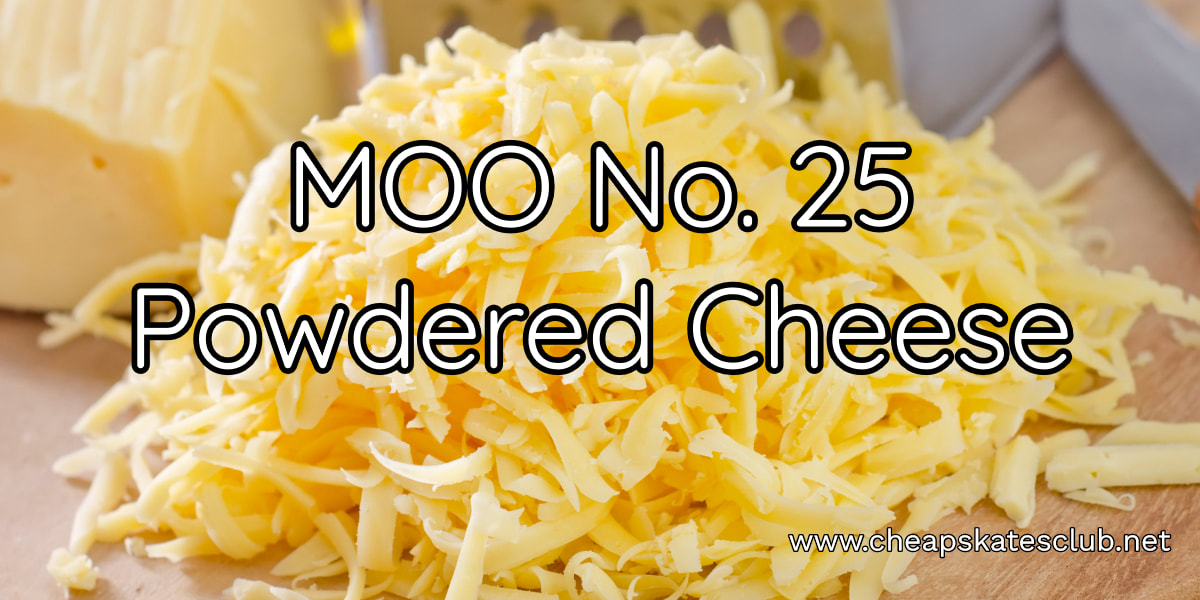31 Days of MOO No. 25 Powdered Cheese
The most common powdered cheese we know here in Australia is the dehydrated parmesan that comes in the green cardboard box. And while it's not as good as fresh, it is still good in cooking and very handy to have on the shelf as it doesn't need to be refrigerated.
But you can MOO other types of powdered cheese, and it's not nearly as complicated as you might think.
Start with a good, sharp cheese for the best flavour, but really, any hard cheese (cheddar, tasty, colby etc.) will work.
You'll need a dehydrator. Yes, a dehydrator. You want the cheese to dry evenly, and this requires good, hot air circulation and a very low temperature. The lower the temperature, the better when it comes to dehydrating cheese.
Take your cheese and grate it. Grated cheese dehydrates faster and more evenly and it only takes a few minutes to grate by hand or even less if you use a food processor (I use the grater blade on my food processor for this).
You'll need some cheesecloth or gauze. I use both, I only have two cheesecloths, but I have six gauze baby wraps I use in the kitchen.
Spread the cheesecloths over the dehydrator trays. They will stop the shards of cheese falling through the holes in the tray as it shrinks, but they'll also help to absorb any grease the cheese releases as it dehydrates.
Spread the cheese in a thin layer over the cheesecloth covered trays and place in the dehydrator.
Set the temperature to 45 degrees Celsius, 110 degrees Fahrenheit.
The cheese will take up to 15 hours to dehydrate. Start checking after 10 hours. You'll know the cheese is fully dry when it is hard, like little stones and you can't break it with a fingernail.
Let it cool completely, then use a coffee grinder, blender or food processor to pulse into a powder.
Store in a clean jar. You can vacuum seal for longer shelf life.
This cheese is shelf stable for up to 12 months.
It makes great cheese sauces, can be used in pasta dishes, to top casseroles, flavour soups and stews, or scrambled eggs etc.
It's also delicious sprinkled on buttered bread and toasted.
Add it to crumbs for extra flavour.
But you can MOO other types of powdered cheese, and it's not nearly as complicated as you might think.
Start with a good, sharp cheese for the best flavour, but really, any hard cheese (cheddar, tasty, colby etc.) will work.
You'll need a dehydrator. Yes, a dehydrator. You want the cheese to dry evenly, and this requires good, hot air circulation and a very low temperature. The lower the temperature, the better when it comes to dehydrating cheese.
Take your cheese and grate it. Grated cheese dehydrates faster and more evenly and it only takes a few minutes to grate by hand or even less if you use a food processor (I use the grater blade on my food processor for this).
You'll need some cheesecloth or gauze. I use both, I only have two cheesecloths, but I have six gauze baby wraps I use in the kitchen.
Spread the cheesecloths over the dehydrator trays. They will stop the shards of cheese falling through the holes in the tray as it shrinks, but they'll also help to absorb any grease the cheese releases as it dehydrates.
Spread the cheese in a thin layer over the cheesecloth covered trays and place in the dehydrator.
Set the temperature to 45 degrees Celsius, 110 degrees Fahrenheit.
The cheese will take up to 15 hours to dehydrate. Start checking after 10 hours. You'll know the cheese is fully dry when it is hard, like little stones and you can't break it with a fingernail.
Let it cool completely, then use a coffee grinder, blender or food processor to pulse into a powder.
Store in a clean jar. You can vacuum seal for longer shelf life.
This cheese is shelf stable for up to 12 months.
It makes great cheese sauces, can be used in pasta dishes, to top casseroles, flavour soups and stews, or scrambled eggs etc.
It's also delicious sprinkled on buttered bread and toasted.
Add it to crumbs for extra flavour.
